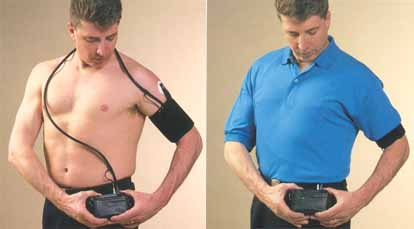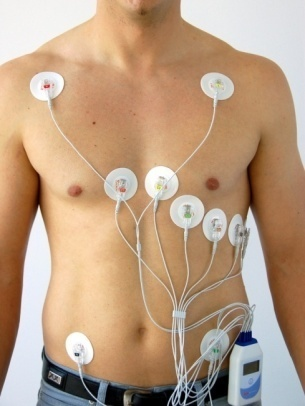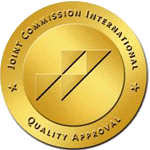Guidelines for preparation and conduct of patient when making ambulatory blood pressure monitoring and electrocardiography
Ambulatory Blood Pressure Monitoring (ABPM)
A diagnostic technique for registration and assessment of 24-hour dynamics of blood pressure in patient’s usual conditions of work and rest. This technique allows finding an individual antihypertensive treatment taking into account 24-hour variations of blood pressure.
The device measures your blood pressure in the same way as a doctor does: by inflating and then gradually deflating the cuff on your shoulder. Measurements are taken automatically at appropriate time intervals: in the daytime every 30 minutes, and at night every 60 minutes.

Holter Monitoring

Provides an opportunity to detect any irregular heart rhythm, myocardial ischemia episodes under exercise conditions and at rest, evaluate the treatment efficacy. This technique is absolutely safe, has no contraindications, and does not require any special preparation. You may need to undergo this test if you are worried by palpitation, heart disorders, episodes of loss of consciousness, and intermittent heart pains.
Many people are worried by heart pains, heart disorders, or increase in arterial blood pressure. Those complaints often occur when walking, in the evening or during sleep. Cardiologist does an electrocardiogram, however the cardiogram does not demonstrate any significant changes. What’s up with that?
An electrocardiogram done at a doctor’s appointment allows evaluating the heart work at rest only, and the duration of recording is 5-10 seconds, that is why an ECG can be inadequate to reveal eventual serious and dangerous heart disorders.
In such cases Holter monitoring can be a helping hand for the patient and doctor as the advanced diagnostic method of cardiovascular diseases. The continuous 24-hour ECG recording (Holter monitoring) allows evaluating the heart work to the full extent.
This technique is highly informative and absolutely safe for the patient.
To obtain full information from test results the attending doctor needs YOUR ACTIVE COOPERATION.
During the whole 24 hour period, please, keep the PATIENT’S DIARY:
A COMPREHENSIVE INTERPRETATION OF MONITORING DATA IS IMPOSSIBLE WITHOUT THE DETAILED DIARY SPECIFYING ALL ACTIVITY MOMENTS, TIME OF TAKING MEDICAMENTS, AND HAVING PHYSICAL LOAD.
Apart from keeping a diary, great importance is attached to the correct behaviour of the patient in the course of monitoring, for which reason the following rules must be complied with:
- During the blood pressure measurement, the arm with pneumatic cuff must be positioned along the body and relaxed (walking patient should stop and lower the arm).
- Any intensive physical load, exercises, and examinations (US, X-ray, MRT, physiotherapy) must be excluded since the electromagnetic field of the equipment can disturb the normal work of this device.
- Driving is undesirable.
- It is undesirable to use such domestic appliances as: vacuum cleaner, hair dryer, microwave oven, and electric razor;
- It is undesirable to put mobile phone or other radio transmitting equipment close to the monitor (cause faulty operation of the device).
- It is not allowed to pass through metal detector or magnetic toll gates.
- Protect the device from entry of any liquid inside of it (hydrotherapeutic and physiotherapeutic procedures must be excluded).
- During the period of monitoring the patient shall keep the detailed diary specifying his or her activities and general state (including during night-time hours, which can be described in the morning after wakening).
- Observance of the work-rest routine.
- It is undesirable to look at the monitor readings since this can induce an anxiety, which may lead to overestimation of the results.




